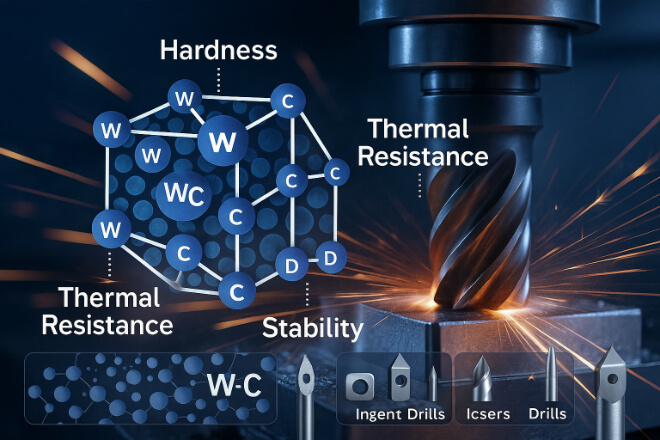기계 가공 분야에서 절삭 속도는 단순한 숫자 이상의 의미를 지닙니다. 절삭 속도는 생산성, 공구 수명, 부품 품질에 직접적인 영향을 미칩니다.
사용시 텅스텐 카바이드 절단 도구올바른 절삭 속도 범위를 이해하는 것이 중요합니다. 잘못 사용하면 과열, 공구 마모, 표면 조도 불량 등의 문제가 발생할 수 있습니다.
이를 올바르게 수행하면 높은 정밀도, 낮은 비용, 원활한 운영이 가능합니다.
이 블로그에서는 초경 공구의 절삭 속도가 어떻게 작용하는지, 어떤 요소가 절삭 속도에 영향을 미치는지, 그리고 다양한 소재에 대해 어떤 범위를 목표로 해야 하는지 알아보겠습니다.
절삭 속도란 무엇인가?
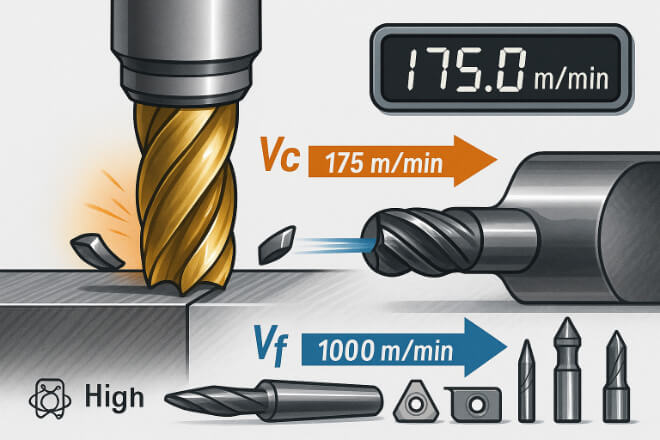
절삭 속도는 공구의 절삭날이 재료 표면을 가로질러 이동하는 속도입니다. 일반적으로 분당 미터(m/min) 또는 분당 표면 피트(SFM)로 측정합니다.
절삭 속도가 빠를수록 도구가 주어진 시간 내에 제거할 수 있는 재료의 양이 늘어나지만, 그만큼 더 많은 열이 발생합니다.
텅스텐 카바이드 공구의 경우 카바이드의 우수한 내열성 덕분에 일반적으로 절삭 속도가 고속강 공구보다 높습니다. 경도.
절삭 속도에 영향을 미치는 요소
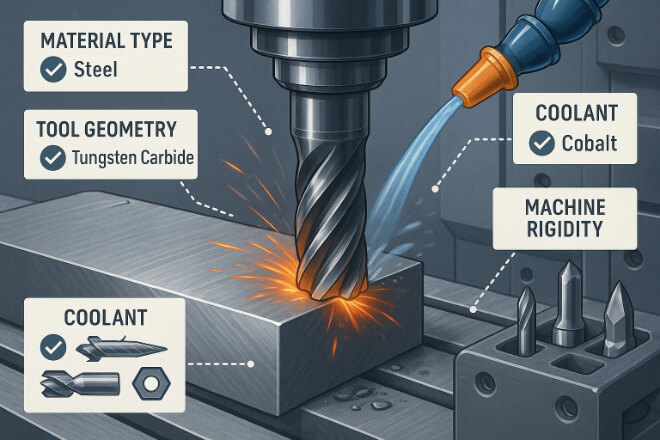
숫자를 계산하기 전에, 절삭 속도는 고정되어 있지 않다는 점을 기억하세요. 절삭 속도는 다음 요인에 따라 달라집니다.
가공물의 재질: 단단한 소재일수록 속도가 느려야 합니다.
공구 기하학: 날카로운 각도와 작은 직경은 속도 조정이 필요할 수 있습니다.
냉각수/윤활유: 냉각이 좋아지면 속도가 더 빨라지는 경우가 많습니다.
기계 강성: 기계가 강할수록 진동 없이 더 빠른 속도를 처리할 수 있습니다.
작업 유형: 거친 가공과 마무리 가공에는 서로 다른 요구 사항이 있습니다.
공구 코팅: TiAlN이나 CVD 다이아몬드와 같은 코팅된 공구는 열에 더 잘 견디므로 더 빠른 속도를 지원합니다.
재료별 권장 절삭 속도
다음은 일반적인 소재에 따른 카바이드 공구의 일반적인 절삭 속도 범위를 보여주는 간단한 표입니다.
| 재료 유형 | 절삭 속도(m/min) | 노트 |
|---|---|---|
| 연강 | 100 – 250 | 건조 또는 가벼운 냉각수 사용 |
| 스테인리스 스틸 | 60 – 150 | 최상의 결과를 얻으려면 코팅된 도구를 사용하세요 |
| 주철 | 80 – 200 | 회주철은 건식 절단에 적합합니다. |
| 알류미늄 | 200 – 600 | 날카로운 도구를 사용한 고속 |
| 티타늄 합금 | 30 – 60 | 냉각수를 충분히 사용하세요 |
| 강화강(45-60 HRC) | 30 – 80 | 특수 카바이드 등급이 필요합니다 |
| 황동/청동 | 100 – 300 | 빌드업 에지의 위험 낮음 |
절삭 속도 대 이송 속도: 혼동하지 마세요
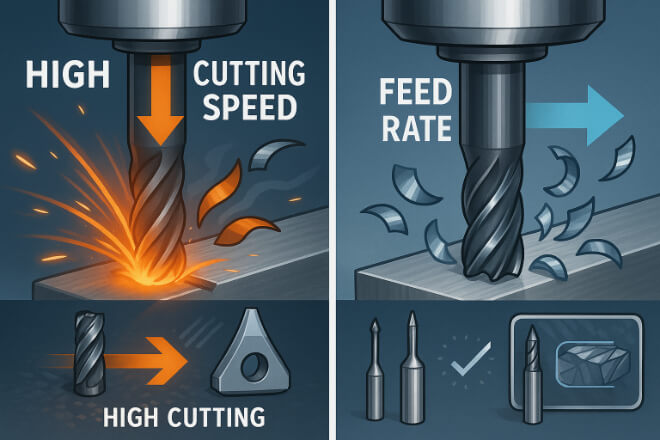
절삭 속도가 절삭 날이 얼마나 빨리 움직이는지를 측정하는 반면, 이송 속도는 공구가 회전당 또는 분당 얼마나 전진하는지를 나타냅니다.
더 높은 절삭 속도 = 더 빠른 재료 제거, 더 많은 열
더 높은 이송 속도 = 더 두꺼운 칩, 더 높은 공구 압력
공구 파손이나 떨림과 같은 문제를 피하려면 속도와 이송 사이에 적절한 균형이 필요합니다.
중간 범위에서 시작하여 도구 마모, 마감 품질, 기계 소리에 따라 조정하세요.
잘못된 절삭 속도로 인한 일반적인 문제
잘못된 속도를 선택하면 공구와 부품이 손상될 수 있습니다. 다음과 같은 몇 가지 문제가 발생할 수 있습니다.
| 문제 | 에 의해 발생 |
|---|---|
| 탄 도구 가장자리 | 속도가 너무 빨라서 냉각수가 없어요 |
| 빌트업 에지(BUE) | 속도가 너무 느리고 소재가 부드럽습니다. |
| 덜거덕거림이나 진동 | 속도-공급 불일치 |
| 짧은 공구 수명 | 속도 조절이 잘 안 됨 |
| 거친 표면 마감 | 속도가 너무 낮거나 불안정합니다 |
초경 공구의 절삭 속도 최적화를 위한 팁
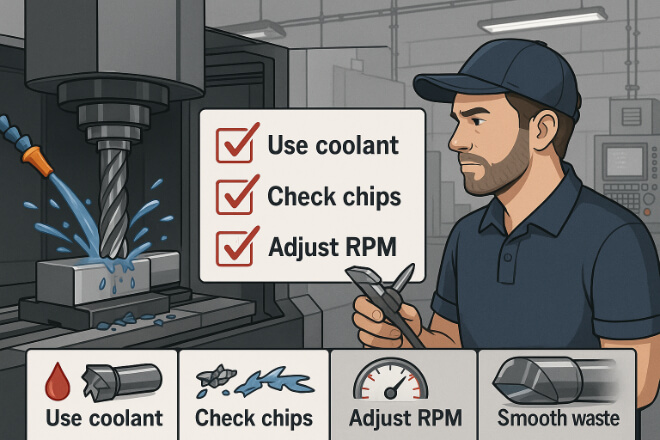
더 매끄럽고, 빠르고, 오래 지속되는 결과를 원하시나요? 다음 팁을 시도해 보세요.
항상 제조업체의 속도 지침을 따르십시오.
견고한 소재에는 코팅된 카바이드 공구를 사용하세요
기계를 단단하고 잘 유지 관리하십시오.
필요한 곳에 적절한 냉각수나 미스팅을 사용하세요
칩 색상과 마감을 기반으로 시험 절단 및 미세 조정을 수행합니다.
전문가 팁: 밝은 은색이나 파란색 칩은 일반적으로 좋은 컷을 나타냅니다. 흐릿하거나 탄 칩은 문제가 있음을 의미합니다.
초경을 이용한 고속 가공(HSM)
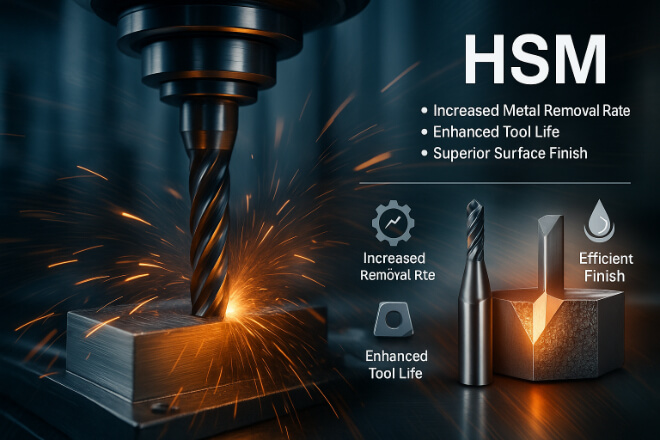
텅스텐 카바이드 공구는 고속 가공(HSM)에 적합합니다. 이 기술은 높은 스핀들 속도와 낮은 절삭 부하를 활용하여 효율성을 높입니다.
카바이드 공구에 HSM을 적용하면 다음과 같은 이점이 있습니다.
더 빠른 사이클 시간
낮은 절삭력
열 변형 감소
더 나은 마감과 더 엄격한 허용 오차
하지만 HSM은 공구, 재료, 기계가 호환되는 경우에만 작동합니다. 동적 밸런싱 및 진동 제어가 필요할 수 있습니다.
고속에서 코팅된 카바이드 공구 사용
코팅은 고속 절삭에 큰 차이를 만듭니다. 코팅의 특징은 다음과 같습니다.
마찰을 줄이세요
열 차단재 역할을 합니다
공구 수명 연장
고속 카바이드 절단에 널리 사용되는 코팅:
| 코팅 유형 | 가장 적합한 | 혜택 |
|---|---|---|
| 티알인 | 강철, 인코넬 | 높은 내열성 |
| 다운로드 가능 콘텐츠 | 알루미늄, 구리 | 안티스틱, 저마찰 |
| CVD 다이아몬드 | 흑연, 복합재 | 극한의 내마모성 |
공구 직경 및 속도 - 알아야 할 사항
작은 공구일수록 동일한 표면 속도에 도달하려면 더 높은 RPM이 필요합니다. 간단한 요약은 다음과 같습니다.
| 공구 직경(mm) | 속도(RPM) @ 100m/min |
|---|---|
| 5mm | 6360 |
| 10mm | 3180 |
| 20mm | 1590 |
| 40mm | 795 |
이 규칙을 사용하세요: 동일한 절삭 속도에서 도구가 클수록 RPM이 낮아집니다.
마지막 생각
텅스텐 카바이드 공구는 고성능 절단을 위해 제작되었지만, 올바르게 사용해야만 가능합니다.
절삭 속도를 적절하게 조절하는 것은 가공 결과를 향상시키는 가장 간단하고 강력한 방법 중 하나입니다.
회사에 대한 자세한 내용을 알고 싶으시면 언제든지 문의해 주세요. 문의하세요.

